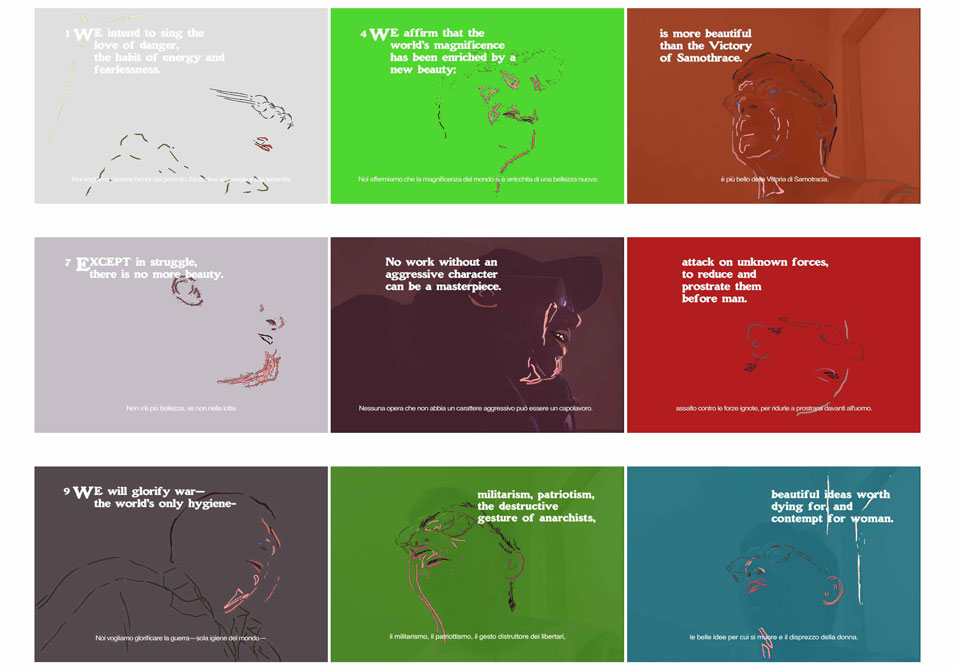Via Artdaily.org
Luca Buvoli (b. 1963) is an Italian-born contemporary artist who now lives in New York City.
LONDON.- One hundred years on from the publication of F.T. Marinetti’s Futurist Manifesto, Luca Buvoli’s multi-media work explores the themes at the very heart of Futurism – dynamism, conflict and the changing society – as well as engaging directly with the contradictions of the movement itself. Velocity Zero is a unique installation comprising film and animation, works on paper, mural painting and sculpture, which will be exhibited at the Estorick Collection of Modern Italian Art, 39a Canonbury Square, London N1, through 19 April 2009. The artist will present a talk at 3pm on Saturday 21 March 2009 about his work and his experience of Futurism.
Luca Buvoli (b. 1963) is an Italian-born contemporary artist who now lives in New York City. In recent years, he has explored the tenets of Futurism, the bombastic Italian movement that began with the publication of Marinetti’s Manifesto in the popular Parisian newspaper Le Figaro on 20 February 1909, in the light of subsequent historical events.
The relationship of Futurism with Italian Fascism, and the clash of its celebration of war with the horrors of the First World War, are of particular interest to Buvoli, who sees in them a relevance to today’s society – a gulf between theoretical ideal and reality that is still pervasive. “I am revisiting Italian Futurism and its cooption by Fascism not out of historical interest, but because of the parallels with demagogic strategies used today by mediative societies… In my work I deal with philosophical, psychological and sociological issues, and try to propose, within a discrete and creative vision, an alternative to our society’s celebration of violence.”
Buvoli has created a new installation for the Estorick Collection. The centrepiece is the video animation Excerpts from: Velocity Zero, in which sections of the Futurist manifesto are read out loud by people with speech difficulties. The halting, difficult speech of the readers is contrasted with the values of speed and efficiency espoused by the Futurists. As the artist explains, “Marinetti’s original celebration of velocity and aggression from his Futurist text is neutralised by its readers’ speech disorders and my subsequent hand-drawn animation of the footage, which at times delays and overlaps images in mimicry of the Futurists’ representation of motion. The result is a sense of fragmentation and incompletion that parallels the struggle of the readers to capture the original text. The purpose of having the manifesto read by people with speech disorders was to utilise the difficulty of communication and the slowing of language in order to symbolically critique the rhetoric of velocity, aggression and violence in our society.” Excerpts from an Italian-language version of the film were used by the Associazioni Italiani Afasici (Italian Aphasia Associations) as part of their campaign to highlight the condition.
The film will be shown in the setting of a gallery decorated with mural paintings designed specifically for the site. This will be complemented by works of sculpture and ‘propaganda posters’ which Buvoli often includes in his installations and which form, according to art critic and writer Jeffrey Kastner, “yet another element that draws out, with the artist’s characteristic subtlety, the socio-political malleability of language and image, and dramatises the chasm that too often divides theory and practice”.
Completing the installation will be a second animated film, A Very Beautiful Day After Tomorrow. The title takes its inspiration from words spoken by F.T. Marinetti to his daughter towards the end of the Second World War, when he was seriously ill and the regime that he had supported was collapsing. He encouraged her not to dwell on current difficulties, but to remember that “There will be a very beautiful day after tomorrow”. The film is described by Christine Poggi, associate professor at the University of Pennsylvania: “As in Sergei Eisenstein’s montage theory, Buvoli employs the collision of juxtaposed shots to spark critical thought about the relation of past and present fantasies of velocity, flight, power and violence. As the video nears its conclusion, it seems to encounter resistance: the soundtrack slows so that the refrain of the patriotic song (‘the motor rumbles’) becomes garbled, while the whirling propellers wind down. The final echoes of the song convey a sense of spatial and temporal distance; it is as if we are present at the far reaches of a stadium, and can hear the booming sounds of the loudspeaker only in blurred and distorted traces.”
Luca Buvoli has achieved considerable acclaim both in Italy and America. Venues hosting his solo shows include the ICA in Philadelphia (2007), the M.I.T. List Visual Arts Center, Cambridge, Massachusetts (2000), the Philadelphia Museum of Art (2001), the Cleveland Center for Contemporary Art (part of Mythopoeia: projects by Matthew Barney, Luca Buvoli, and Matthew Ritchie) (1999), the Santa Monica Museum of Art, CA (1996), the Queens Museum of Art, NY (2001), the Weatherspoon Art Museum, Greensboro, NC (2003), the Glassell School of Art of the Museum of Fine Arts, Houston (2003), and the John Weber Gallery, New York (1995, ’97, ‘99). Group shows include the 2nd Johannesburg Biennale, South Africa (1997), and Greater New York at PS1, New York (2000). Several recent works, part of a large multi-media installation, have recently been shown at the 52nd Venice Biennale, at the entrance of the Arsenale. His animated works have been shown at the Museum of Modern Art, New York (2004), the Lincoln Center (1998), the ICA in Boston (1997), the ICA in London (1998) and the British Library (2008), among other places. Articles on his works have appeared in numerous newspapers and journals including The New York Times, The New Yorker, Flash Art, Frieze, Art on Paper, Art in America and ArtNews.
